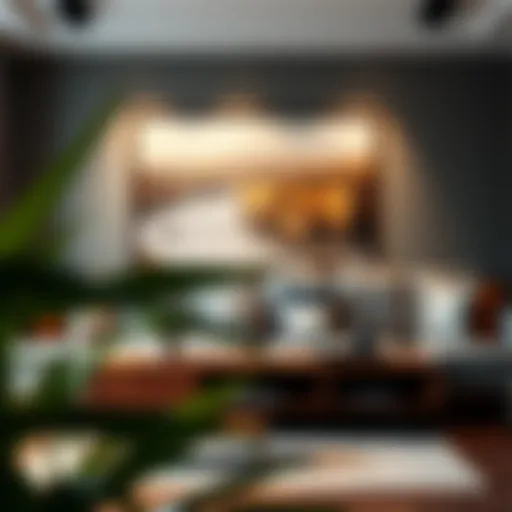A Comprehensive Guide to Measuring Painting Area
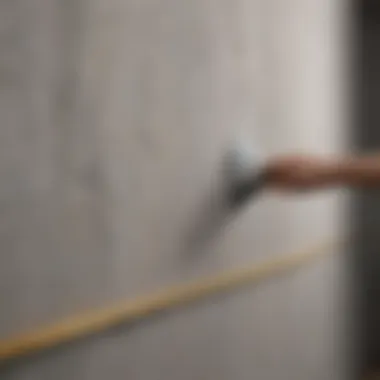
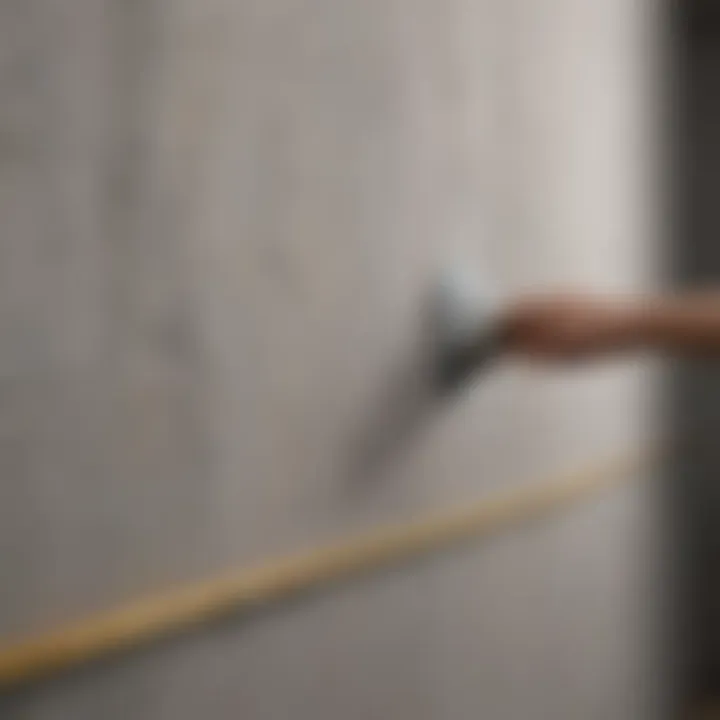
Intro
Accurate measurement of painting area is vital in achieving successful painting projects. Whether painting the interior walls of a cozy home or the exterior of a grand building, understanding how to measure surfaces needing paint is essential. This ensures that resources are allocated efficiently and budgets remain intact. Moreover, it contributes to achieving the desired aesthetic outcomes that every homeowner and professional aspires to obtain.
In this guide, readers will find a systematic approach to quantifying various surface types, including interiors, exteriors, and even unique architectural features. Alongside methods for calculating areas, attention will be given to specific considerations, such as dealing with windows, doors, and irregular shapes. This comprehensive exploration targets both home enthusiasts and professionals, arming them with the necessary tools to prepare effectively for their painting endeavors.
Featured Homes
When it comes to measuring painting areas, understanding different architectural styles can be beneficial. Each style may present unique challenges and opportunities when calculating area. Traditional style homes, for instance, often have intricate moldings and details that require careful measurement. Meanwhile, contemporary designs might involve larger, more open spaces that simplify area calculations. Knowing the particularities of the architectural style ensures that every corner is accounted for when preparing to paint.
Architectural Styles
- Victorian: Known for decorative details. Measurements should include peaks and eaves.
- Modern: Features flat surfaces. Easier to measure overall square footage.
- Colonial: Symmetrical design. Focus on rectilinear areas.
- Craftsman: Low-pitched roofs and overhangs. Pay attention to beams and brackets.
Each architectural style influences not only the measurement process but also the type of paint and technique used. Unique design elements, such as bay windows or vaulted ceilings, also require careful consideration during area calculations.
Unique Design Elements
Elements such as windows and doors often disrupt the flat surface area calculations. To ensure accurate measurements:
- Measure the dimensions of each window and door separately.
- Subtract the area from the total wall measurements.
- Consider special architectural details like alcoves or built-ins.
This focus on specific elements helps in defining the correct area to be painted, ensuring that no space goes unnoticed.
"Accurate area measuring is crucial for budget accuracy and resource allocation."
The essence of this guide lies in balancing precise methods with practical consideration. By recognizing unique building characteristics, you foster an environment where painting projects can thrive. The next sections will delve deeper into techniques, tools, and other fundamental elements necessary for achieving painting success.
Understanding Painting Area
Accurate measurement of painting area is critical for any painting project. This section discusses its significance, highlights essential definitions, and examines factors that influence area measurement. Understanding these elements ensures that resources are utilized efficiently and budgets are adhered to, contributing to both aesthetic and functional outcomes in various settings.
Definitions and Importance
To begin, we need to define what a painting area actually is. The painting area refers to the total surface that requires coverage with paint. Understanding this area is vital not just for homeowners engaged in DIY projects but also for professionals managing larger tasks. A clear grasp of the painting area helps in estimating material costs and labor, ensuring that no resources are wasted. Accurate calculations prevent over-purchase or under-purchase of paint, both of which can lead to financial inefficiencies. For anyone investing time and resources into a painting job, grasping the total area to be painted is paramount.
Factors Influencing Area Measurement
The measurement of painting area is influenced by various factors, which directly affect the precision of calculations. These factors include surface texture, type of paint, and environmental conditions. Each one plays a unique role in how much paint is needed, and they’re worth discussing in detail.
Surface Texture
Surface texture greatly affects paint application and coverage. Smooth surfaces, like those of freshly drywall or plaster, tend to require less paint to achieve even coverage. In contrast, porous or uneven textures absorb more paint, leading to higher paint consumption. For example, a stucco surface might seem appealing due to its aesthetic properties, but it can significantly increase the amount of paint required to cover its irregularities.
Choosing the right texture to paint is not just about visual appeal; it also impacts overall cost-effectiveness. Therefore, understanding how different surfaces behave can save both time and money.
Type of Paint
The type of paint selected for a project also influences coverage and, consequently, area measurement. Different paints come with varying coverage rates per gallon. For instance, high-quality acrylic paints often provide better coverage compared to latex paints. This is essential information when calculating how much paint is necessary.
Moreover, the finish of the paint, whether matte, satin, or glossy, has implications for the visual outcome of a project. Some finishes might require multiple coats to achieve the desired appearance, thereby affecting how much paint needs to be purchased. Thus, understanding paint types helps in making informed decisions during the planning phase of any project.
Environmental Conditions
Environmental conditions, including humidity, temperature, and airflow, can affect paint application and drying times. For instance, high humidity can cause paint to take longer to dry, which may lead to running or streaking if not monitored carefully.
Choosing the right time to paint can be as important as choosing the right color or surface. Low humidity and moderate temperatures are often considered ideal conditions for painting. Understanding these conditions allows for better planning and helps ensure successful results.
"Effective measurement requires an awareness of factors such as surface conditions, paint types, and environmental influences to ensure optimal results in painting projects."
Recognizing these factors is key when preparing for painting. They play significant roles in guiding effective area measurement and contribute enormously to the success of the project.
Essential Tools for Measurement
Accurate area measurements rely heavily on the utilitization of specific tools designed for this purpose. Essential tools for measurement not only enhance precision but also streamline the process of quantifying areas that require painting. Understanding and selecting the right tools can significantly affect the outcome of a project.
Factors such as time efficiency, ease of use, and accuracy come into play when considering which tools to include in your toolkit. Depending on the size of the area and the shapes involved, tools can range from simple measuring tapes to advanced digital devices. This section will explore three main tools: measuring tapes, laser distance measures, and digital measuring devices.
Measuring Tapes
Measuring tapes are perhaps the most traditional yet indispensable tools when measuring painting areas. They are typically easy to use and inexpensive, making them ideal for both amateurs and professionals.
Benefits of Using Measuring Tapes:
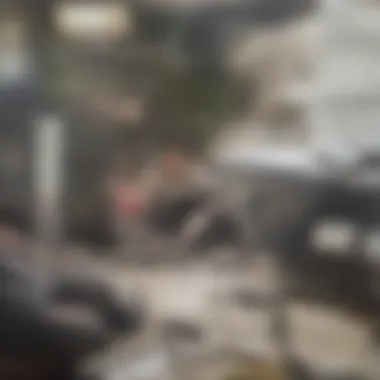
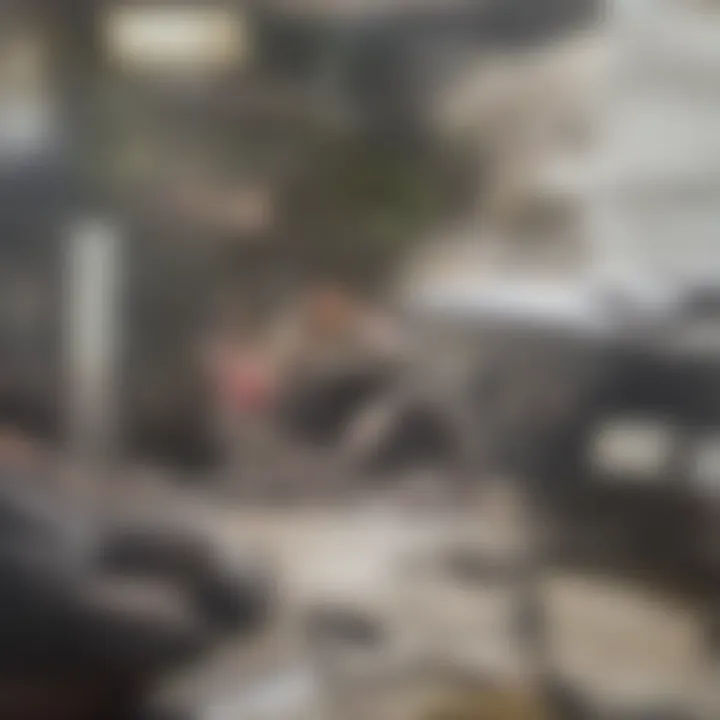
- Simplicity: These tools are straightforward to use. All you need to do is extend the tape and read the measurement.
- Flexibility: Measuring tapes can conform to various surfaces and angles, allowing for measurements in challenging spaces.
- Portability: They are lightweight and easy to carry, making them suitable for both indoor and outdoor use.
However, users should ensure that they keep the tape taut for the most accurate readings. Additionally, care must be taken with longer distances, as reading the tape can become challenging without assistance.
Laser Distance Measures
Laser distance measures have revolutionized measuring practices, offering increased accuracy and speed. These devices employ a laser beam to calculate the distance from the device to a target point.
Considerations when using Laser Distance Measures:
- Precision: They provide measurements that are often more accurate than those taken by hand, especially over longer distances.
- Convenience: Many models offer features like memory storage and area calculation, making them user-friendly.
- Less Physical Strain: There’s no need for bending or stretching, reducing the physical effort required to take measurements.
That said, these devices often require batteries and may not function well in bright sunlight. Hence, it is best to use them in favorable lighting conditions for optimal results.
Digital Measuring Devices
Digital measuring devices, such as digital tape measures or smart measuring tools, are designed for those who seek high-tech solutions for area calculation. Using advanced technology, these devices can not only measure distances but often integrate with applications for detailed drawings or area calculations.
Advantages of Digital Measuring Devices:
- Speed: They typically provide instant readings, significantly cutting down the time needed for manual calculations.
- Integration: Many devices connect to smartphones and tablets, offering features for automated calculations and documentation.
- Multifunctional: Some can measure area, volume, and calculate square footage, all of which can be beneficial for painting projections.
Despite their advantages, users should remain mindful of the learning curve associated with each device. Familiarizing oneself with the functions ensures better results.
Preparation for Area Calculation
Preparation for measuring painting area is a critical step that ensures accuracy and efficiency in the painting process. This phase involves gathering relevant information and creating a clear plan on how to approach the area calculation. Meticulous preparation minimizes errors and helps avoid costly mistakes, enhancing both resource allocation and labor management.
Gathering Required Information
The first step in preparation is to collect all necessary information about the space to be painted. This includes details such as dimensions of the walls, windows, doors, and any architectural features that might affect the calculation.
To start, it is advisable to have the following items:
- A measuring tape or a laser distance measure
- A notebook or digital device to record measurements
- A calculator for quick computations
Accurate measurements are essential. They will guide the entire project scope, including estimating the quantity of paint required. A common oversight is measuring only wall dimensions without considering other elements like windows or decorative trim. Including these factors ensures that total area calculations are precise, which ultimately leads to proper budgeting and purchase of materials.
Sketching the Area
Creating a simple sketch of the area is another important preparation step. This visual representation allows for easy identification of the space dimensions and features that will influence the area calculations.
You don’t need to be an artist; a basic outline will suffice. Include:
- Wall lengths
- Locations of windows and doors
- Heights, especially in spaces with varying elevations such as vaulted ceilings
A sketch not only assists in measurements but also helps visualize work sequences and plan other details like color schemes and finishes. Furthermore, having a visual guide makes it easier to identify areas that may need more attention, such as high ceilings or intricate moldings.
"Preparation in measurements saves time and costs on a painting project. Good planning leads to better execution."
Investing time in these preparation steps pays off significantly in the painting process. Through careful planning and information gathering, the project can proceed smoothly, minimizing disruptions and ensuring outstanding results.
Calculating Area for Standard Shapes
Understanding how to calculate area for standard shapes is vital in painting projects. It allows for precise estimations on how much paint will be needed, facilitating accurate budgeting and resource allocation. Getting these calculations right can eliminate waste and help achieve a more seamless finish, especially in larger rooms or spaces with complex designs.
Calculating standard shapes involves familiar geometric formulas that are generally easy to remember and apply. These equations cover rectangles, squares, and circles, which are common in most interior and exterior layouts. Knowing how to determine the area of these shapes sets a strong foundation for more complicated calculations, such as those for irregular shapes later in this guide.
Calculating Rectangle Areas
To find the area of a rectangle, the formula is straightforward: Area = Length × Width. This calculation is crucial for many rooms, given their tendency to have rectangular dimensions.
- Measure the Length and Width: Use a measuring tape to get accurate dimensions. Ensure you measure from wall to wall, excluding any irregularities like baseboards unless they will affect painting coverage.
- Perform the Calculation: Multiply the length and width. For example, if a room is 12 feet long and 10 feet wide, the area equals 120 square feet.
- Consider Multiple Surfaces: If you have multiple rectangles, such as an adjoining hallway or separate alcoves, calculate each area individually and sum them up for the total.
Calculating Square Areas
Calculating a square area is even simpler, as it uses the formula: Area = Side × Side or Area = Side². Since all sides of a square are equal, measuring just one side will suffice.
- Measure One Side: Use the measuring tape again. For example, if one side of the square is 8 feet, your calculation is straightforward.
- Use the Formula: Square the result. In this case, Area = 8 feet × 8 feet = 64 square feet.
- Identify Additional Squares: Just like rectangles, if dealing with multiple squares in one space, add their areas together for total coverage requirements.
Calculating Circular Areas
Calculating the area of a circle requires a different approach, given it uses the formula: Area = π × Radius². Here's how to apply it effectively:
- Find the Radius: Measure from the center of the circle to the edge. If you have a diameter, divide by two to find the radius.
- Input the Value: Use π (approximately 3.14) for your calculation. If a room has a circular shape with a radius of 5 feet, the area calculation would be Area = 3.14 × (5 feet × 5 feet) ≈ 78.5 square feet.
- Include Multiple Circular Areas: If there are several circular elements in the space, such as pillars or columns, calculate their areas individually and sum them up.
In summary, accurately calculating area for standard shapes is a skill that streamlines painting projects. By mastering these basic formulas and principles, any paint job will have a well-informed foundation, minimizing waste and maximizing efficiency.
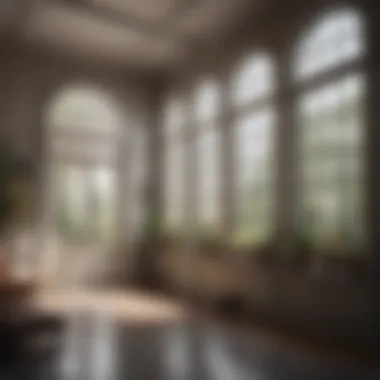
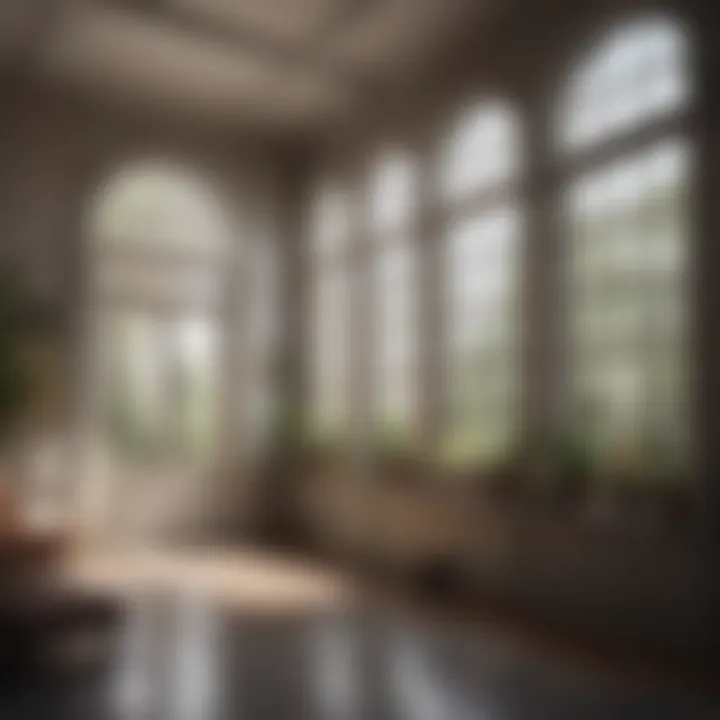
Calculating Area for Irregular Shapes
Measuring area for irregular shapes poses significant challenges, often requiring tailored techniques to achieve accuracy. Many structures and objects do not conform to standard geometric forms, making conventional area calculations ineffective. Understanding how to tackle these irregularities ensures the efficient allocation of paint and resources. Accurate measurements help in budgeting and can drastically reduce material waste, resulting in improved project outcomes.
Using Grid Methods
The grid method is a widely recognized technique for calculating areas of irregular shapes. This approach involves overlaying a grid on top of the object, allowing one to count the squares that fall within the boundary.
Steps to Effectuate the Grid Method:
- Create a Grid: Use graph paper or draw a grid on a digital platform. Ensure that each square represents a uniform area.
- Overlay the Grid: Place the grid over the irregular shape. Adjust the grid so that it covers the entire area to be measured.
- Count Full and Partial Squares: Count the squares that are fully within the shape. For partial squares, use a consistent method such as counting half as a full square.
- Calculate Area: Multiply the number of counted squares by the area each square represents to arrive at the total area.
This method may introduce some estimation, but it provides a practical solution when exact measurements are challenging.
Employing Triangulation
Triangulation is another useful technique for measuring irregular shapes. It involves breaking down the shape into a series of triangles, making calculations simpler and more manageable. This method is particularly beneficial in architectural settings where forms are non-linear.
Procedural Steps for Triangulation:
- Identify Points: Mark several key points around the perimeter of the irregular shape.
- Form Triangles: Connect these points to create triangles. Ensure that the triangles cover the entire area without any overlaps.
- Measure Each Triangle: Use a ruler or a measuring tool to find the base and height of each triangle.
- Calculate Area of Each Triangle: Utilize the formula:
[ \textArea = \frac12 \times \textbase \times \textheight ]
Calculate the area for each triangle and sum them up for a total area.
Both the grid and triangulation methods emphasize flexibility in measuring. These approaches are essential in rendering accurate paint area calculations while accommodating the intricacies that irregular shapes present. Utilizing these techniques can significantly enhance project accuracy and cost effectiveness.
Adjusting Measurements for Architectural Features
Understanding how to effectively adjust measurements for architectural features is essential for anyone engaged in painting projects. This section addresses factors such as windows, doors, and ceiling heights, which can dramatically influence the total area that requires painting. Recognizing these elements ensures more accurate calculations, prevents overestimating the amount of paint needed, and assists in budgeting effectively. Careful consideration of these features not only avoids waste but also leads to a more polished final result, enhancing both aesthetic appeal and functionality.
Incorporating Windows
When considering the area to be painted, windows represent a significant factor that should not be overlooked. Their inclusion – or exclusion – in measurements can alter the total painting area substantially. To incorporate windows into your calculations:
- Measure Each Window: Determine the height and width of each window.
- Calculate Total Window Area: Multiply the height by the width for each window, then sum these areas.
- Subtract from Total Area: When you calculate the total surface area intended for painting, be sure to subtract the combined area of the windows.
This push to consider windows is important, as neglecting them can lead to an inflated estimate of paint needed, causing unnecessary expenses.
Factoring in Doors
Doors are another crucial architectural feature that affects paint measurements. Much like windows, doors create areas that do not require paint. Here are some tips to accurately account for doors:
- Take Measurements: Measure the height and width of each door.
- Compute Total Door Area: Find the area of each door by multiplying the height and width.
- Adjust Total Area: Subtract the calculated door area from the total area designated for painting.
Considering the doors in your measurements ensures that resources are appropriately allocated and that expenditures remain within budget.
Consideration of Ceiling Heights
Ceiling heights play a vital role when determining total paint requirements, particularly in larger spaces. Standard room ceilings are generally 8 to 9 feet high, but many homes have varied ceiling heights, which should influence your calculations.
To accurately measure for varying ceiling heights, follow these steps:
- Determine Height Variations: Measure the height of the ceiling at its highest and lowest points.
- Adjust Surface Area Accordingly: Calculate the total wall area using the different heights, as this may mean more or less paint is required depending on the specifics of the room.
Accurate calculations ensure no unnecessary paint is purchased and helps maintain budgetary constraints, which is critical for any painting project.
In summary, adjusting measurements for windows, doors, and ceiling heights is not just a matter of precision; it directly impacts the overall efficiency of the painting project. Taking these factors into account allows individuals and professionals alike to budget and plan effectively, leading to enhanced project outcomes.
Calculating Total Paint Requirement
Accurate calculation of the total paint requirement is vital for any painting endeavor. Calculating how much paint is needed not only helps in budgeting but also ensures that projects proceed without interruptions due to paint shortages. This section discusses key elements that impact the total paint calculation. Understanding these factors will aid in making informed decisions, ultimately leading to more successful painting outcomes.
Estimating Coverage per Gallon
The first step in estimating the total paint required is determining how much area a gallon of paint will cover. This coverage can vary based on the type of paint and the surface being painted. Generally, one gallon of paint covers approximately 350 to 400 square feet. However, certain conditions may affect this estimate. For instance, textured surfaces might absorb more paint compared to smooth finishes. It is essential to check the manufacturer's specifications for coverage rates, as they often provide detailed information on the expected coverage for different application methods.
Adjusting for Multiple Coats
In many painting situations, multiple coats of paint are necessary to achieve the desired color depth and finish. When planning for this, it is crucial to adjust the total calculated paint requirement accordingly. Each additional coat will increase the paint needed. A common practice is to factor in an additional 25% for each extra coat after the first. This adjustment helps to ensure that you have enough paint on hand to complete the job without delays.
- For example, if the area requires a total coverage of 400 square feet:
- First coat: 1 gallon
- Second coat: 1 gallon
- Total: 2 gallons
Accounting for Waste Factors
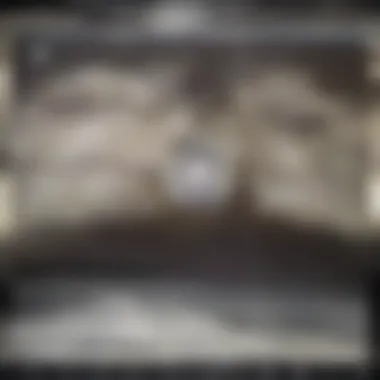
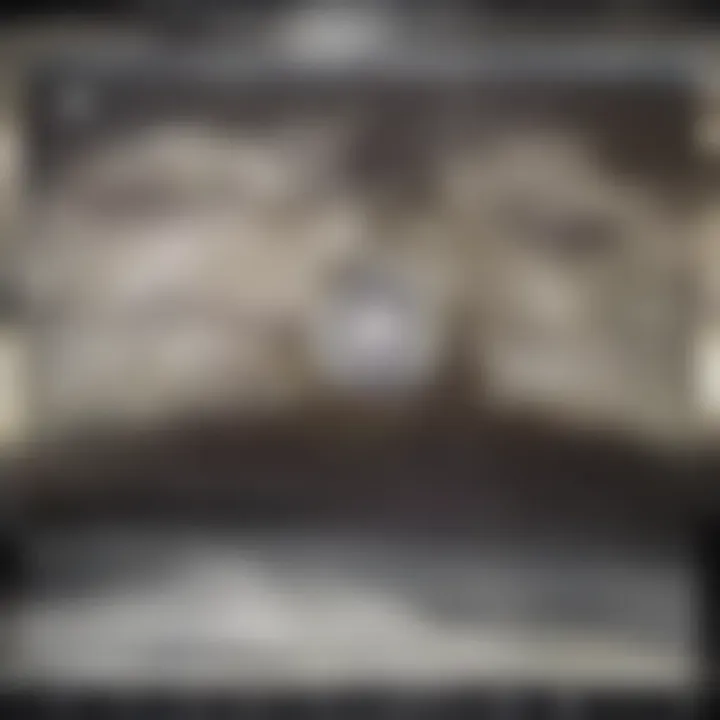
Another significant aspect of calculating total paint needs is factoring in waste, which can occur during mixing, spills, or application. Industry standards suggest accounting for 10-15% of waste when estimating paint requirements. This extra allowance helps prevent disappointment when the paint runs out unexpectedly. To minimize waste:
- Aim for precise measurements and careful application.
- Use tools like rollers and brushes that minimize excess paint on surfaces.
- Consider any touch-ups or future repairs when determining how much total paint to purchase.
Always remember: Accounting for these factors ensures a smoother painting process and leads to better overall results in your project.
Best Practices for Accurate Measurements
Accurate measurements are critical in the realm of painting area calculations. This section outlines the best practices to ensure precision throughout the measurement process. Following these guidelines can significantly reduce errors, save resources, and result in a more efficient painting project. It is important to not just rely on estimation but to engage in meticulous measurements. This approach allows you to make informed decisions on the amount of paint needed and budget considerations.
Recording Measurements
Recording measurements effectively is one of the foundational steps in guaranteeing accuracy. It is crucial to use a consistent format while noting dimensions. This could include labeling the measurement with its respective location and purpose. For instance, if measuring a wall for one coat of paint, state the height and width, and note the total area calculated. This organized approach helps in avoiding confusion later in the project.
Consider using a digital device for recording measurements. Many apps are available to track measurements, converting them automatically into area calculations. This minimizes human error and makes adjustments easier if needed. Make it a habit to review the recorded figures after each measurement. This habit allows you to catch any inconsistencies early on.
Double-Checking Calculations
After measurements have been recorded, double-checking calculations is a vital practice. This step acts as a safeguard against errors introduced during the recording or calculation processes. Use a systematic method to verify your work; this could include recalculating measurements or confirming the values against the original figures you recorded.
One effective strategy is to involve a second individual in the re-evaluation. A fresh set of eyes can often spot mistakes that could be overlooked. Moreover, relying on multiple methods, such as computational tools in tandem with manual calculations, provides a useful safety net.
"An error in calculation can result in wastage of time and resources. Always double-check your figures."
Engaging Professionals When Necessary
Sometimes, engaging professionals is the most pragmatic approach, especially for complex projects. There are instances where the area to be painted contains unique architectural features, or when the surfaces have irregular dimensions. In these cases, professional services can provide accurate estimates based on experience and specialized tools.
Hiring professionals is not just about having someone else do the work; it is also about utilizing their expertise in measuring and planning. Many professionals have sophisticated devices that provide precise measurements and can account for elements that may be overlooked by the average person.
In summary, following best practices in measuring painting area can enhance the effectiveness of your painting project significantly. By maintaining organized records, validating calculations, and knowing when to consult experts, you set a strong foundation for success.
Common Mistakes in Measurement
Accurate numbers in area measurement can significantly influence the success of a painting project. Errors can lead to overspending on materials, time delays, and unsatisfactory finishes. Understanding common pitfalls is crucial for both inexperienced painters and seasoned professionals. Avoiding these mistakes ensures that resources are allocated efficiently and the end result meets expectations.
Ignoring Surface Irregularities
Surface irregularities can range from minor texture differences to major architectural features. These imperfections often affect how paint adheres and its final appearance. Ignoring them can lead to uneven coverage, unintended color variations, and a generally poor aesthetic. Before starting a project, it is essential to closely inspect all surfaces.
- Assess the walls for bumps, dips, or cracks.
- Check for previously applied finishes that may impact adhesion.
- Consider how these imperfections will absorb paint differently.
When measuring, it may be helpful to account for these irregularities by adding additional area to your calculations. This ensures sufficient paint is on hand to achieve an even coat, regardless of the surface condition. Neglecting to address these factors can result in increased costs and labor.
Underestimating Coverage Rates
Coverage rates refer to how much area a gallon of paint can effectively cover, which often depends on the type of paint, surface condition, and method of application. Miscalculating these rates is a frequent oversight, leading to insufficient paint supply or, alternatively, excessive leftovers. Each paint product has a specified coverage rate, usually indicated on the label. Here are key points to consider:
- Surface texture matters: Rough or porous surfaces will require more paint than smooth surfaces.
- Multiple coats: Plan for additional coverage if more than one coat of paint is necessary.
- Application technique: Brushing, rolling, and spraying can each yield different coverage results.
It’s prudent to do a test patch on the surface to better estimate how much you will need before committing to full area calculations. An underestimation in coverage could derail your timeline and budget, making proper evaluation essential.
"Effective preparation and understanding of common mistakes can save significant time and resources in painting projects."
Being mindful of surface irregularities and accurately estimating paint coverage can help prevent wasted materials and effort, leading to a more successful outcome. By avoiding these common mistakes, painters can ensure a smoother, more efficient process and superior results.
End and Further Considerations
The conclusion is not merely a closing statement; it summarizes the insights gained throughout the article while also emphasizing areas for further exploration. This section highlights the essential methods for measuring painting areas effectively. It reinforces the need for precision and accuracy. This is crucial when engaging in any painting project, whether it is for aesthetic improvement or functionality. A comprehensive understanding enables enthusiasts and professionals to avoid common pitfalls associated with inaccurate measurements.
Reviewing the Process
Reviewing the process involves going back through the steps taken to measure and calculate the painting area. It serves as a reminder of the importance of each stage in ensuring a successful outcome. One should revisit each method employed and the tools used. Look at how factors such as surface texture and environmental conditions may have affected measurements.
- Surface Texture can lead to unexpected flaws in measurements if not accurately addressed.
- Ensure that tools are appropriately calibrated. Misuse of a laser distance measure can lead to a miscalculated total area.
- Always consider the impact of doors and windows when calculating the total area needing paint.
This review is essential for identifying any discrepancies or mistakes. It encourages learning from experiences and re-evaluating techniques for future projects.
Future Trends in Area Measurement
As technology advances, changes in area measurement practices become apparent. The use of augmented reality (AR) and smart measuring devices is on the rise. Smart technology allows homeowners and professionals to obtain more accurate measurements swiftly.
Current innovations focus on streamlining the process:
- Smartphone Apps such as Measure or Photo Measures enable quick calculations and save data.
- Laser technology continues to improve, offering even more precise readings.
- 3D scanning technology can create detailed models of spaces, making area calculation simple.
The future of area measurement is likely to change, making it an exciting field for anyone involved in interior design or property renovation. Keeping up with these advancements ensures that enthusiasts can adapt to new methodologies, optimizing their painting projects.
Accurate area measurement is foundational in painting projects, impacting material costs and final results.















